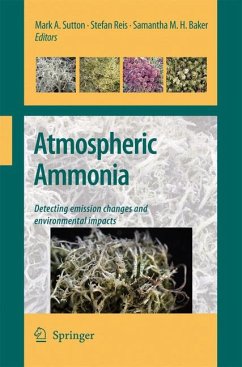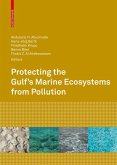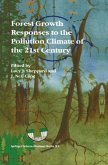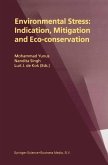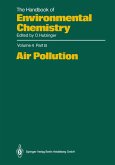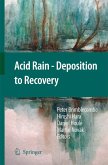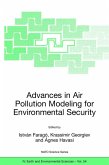Atmospheric Ammonia (eBook, PDF)
Detecting emission changes and environmental impacts. Results of an Expert Workshop under the Convention on Long-range Transboundary Air Pollution
Redaktion: Sutton, Mark; Baker, Samantha; Reis, Stefan


Alle Infos zum eBook verschenken

Atmospheric Ammonia (eBook, PDF)
Detecting emission changes and environmental impacts. Results of an Expert Workshop under the Convention on Long-range Transboundary Air Pollution
Redaktion: Sutton, Mark; Baker, Samantha; Reis, Stefan
- Format: PDF
- Merkliste
- Auf die Merkliste
- Bewerten Bewerten
- Teilen
- Produkt teilen
- Produkterinnerung
- Produkterinnerung

Hier können Sie sich einloggen

Bitte loggen Sie sich zunächst in Ihr Kundenkonto ein oder registrieren Sie sich bei bücher.de, um das eBook-Abo tolino select nutzen zu können.
Anthropogenic emissions of ammonia cause a host of environmental impacts, including loss of biodiversity, soil acidification and formation of particulate matter in the atmosphere. Under the auspices of the UNECE Convention on Long Range Transboundary Air Pollution, around 80 international experts met to review the state of scientific knowledge. This book reports their analysis. It concludes that threshold levels for ammonia effects have been underestimated and sets new values, it assesses the independent evidence to verify reported reductions in regional ammonia emissions, and it reviews the…mehr
- Geräte: PC
- ohne Kopierschutz
- eBook Hilfe
- Größe: 27.8MB
![Protecting the Gulf's Marine Ecosystems from Pollution (eBook, PDF) Protecting the Gulf's Marine Ecosystems from Pollution (eBook, PDF)]() Protecting the Gulf's Marine Ecosystems from Pollution (eBook, PDF)72,95 €
Protecting the Gulf's Marine Ecosystems from Pollution (eBook, PDF)72,95 €![Forest Growth Responses to the Pollution Climate of the 21st Century (eBook, PDF) Forest Growth Responses to the Pollution Climate of the 21st Century (eBook, PDF)]() Forest Growth Responses to the Pollution Climate of the 21st Century (eBook, PDF)112,95 €
Forest Growth Responses to the Pollution Climate of the 21st Century (eBook, PDF)112,95 €![Environmental Stress: Indication, Mitigation and Eco-conservation (eBook, PDF) Environmental Stress: Indication, Mitigation and Eco-conservation (eBook, PDF)]() Environmental Stress: Indication, Mitigation and Eco-conservation (eBook, PDF)112,95 €
Environmental Stress: Indication, Mitigation and Eco-conservation (eBook, PDF)112,95 €![Global Atmospheric Chemical Change (eBook, PDF) Global Atmospheric Chemical Change (eBook, PDF)]() Global Atmospheric Chemical Change (eBook, PDF)62,95 €
Global Atmospheric Chemical Change (eBook, PDF)62,95 €![Air Pollution (eBook, PDF) Air Pollution (eBook, PDF)]() Air Pollution (eBook, PDF)72,95 €
Air Pollution (eBook, PDF)72,95 €![Acid Rain - Deposition to Recovery (eBook, PDF) Acid Rain - Deposition to Recovery (eBook, PDF)]() Acid Rain - Deposition to Recovery (eBook, PDF)112,95 €
Acid Rain - Deposition to Recovery (eBook, PDF)112,95 €![Advances in Air Pollution Modeling for Environmental Security (eBook, PDF) Advances in Air Pollution Modeling for Environmental Security (eBook, PDF)]() Advances in Air Pollution Modeling for Environmental Security (eBook, PDF)72,95 €
Advances in Air Pollution Modeling for Environmental Security (eBook, PDF)72,95 €-
-
-
Dieser Download kann aus rechtlichen Gründen nur mit Rechnungsadresse in A, B, BG, CY, CZ, D, DK, EW, E, FIN, F, GR, HR, H, IRL, I, LT, L, LR, M, NL, PL, P, R, S, SLO, SK ausgeliefert werden.
- Produktdetails
- Verlag: Springer Netherlands
- Seitenzahl: 464
- Erscheinungstermin: 30. Dezember 2008
- Englisch
- ISBN-13: 9781402091216
- Artikelnr.: 37341015
- Verlag: Springer Netherlands
- Seitenzahl: 464
- Erscheinungstermin: 30. Dezember 2008
- Englisch
- ISBN-13: 9781402091216
- Artikelnr.: 37341015
- Herstellerkennzeichnung Die Herstellerinformationen sind derzeit nicht verfügbar.
